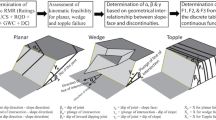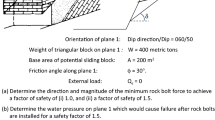Abstract
Complex slopes are characterized by large numbers of failure modes, cut sets or link sets, or by statistical dependence between the failure modes. For such slopes, a systematic quantitative method, or matrix-based system reliability method, was described and improved for their reliability analysis. A construction formula of event vector c E was suggested to solve the difficulty of identifying any component E in sample space, and event vector c of system events can be calculated based on it, then the bounds of system failure probability can be obtained with the given probability information. The improved method was illustrated for four copper mine slopes with multiple failure modes, and the bounds of system failure probabilities were calculated by self-compiling program on the platform of the software MATLAB. Comparison in results from matrix-based system reliability method and two generic system methods suggests that identical accuracy could be obtained by all methods if there are only a few failure modes in slope system. Otherwise, the bounds by the Ditlevsen method or Cornell method are expanded obviously with the increase of failure modes and their precision can hardly satisfy the requirement of practical engineering while the results from the proposed method are still accurate enough.
Similar content being viewed by others
References
YANG Kun, WANG Tong-xu, MA Zhi-tao. Application of cusp catastrophe theory to reliability analysis of slopes in open-pit mines [J]. Mining Science and Technology, 2010, 20(1): 71–75.
PARK H J, UM J G, WOO I, KIM J W. Application of fuzzy set theory to evaluate the probability of failure in rock slopes [J]. Engineering Geology, 2012, 125(27): 92–101.
HICKS M A, SPENCER W A. Influence of heterogeneity on the reliability and failure of a long 3D slope [J]. Computers and Geotechnics, 2010, 37(7/8): 948–955.
JI J, LIAO H J, LOW B K. Modeling 2-D spatial variation in slope reliability analysis using interpolated autocorrelations [J]. Computers and Geotechnics, 2012, 40: 135–146.
SAMUI P, LANSIVAARA T, KIM D. Utilization relevance vector machine for slope reliability analysis [J]. Applied Soft Computing, 2011, 11(5): 4036–4040.
LOW B K. Reliability analysis of rock slopes involving correlated non-normals [J]. International Journal of Rock Mechanics & Mining Sciences, 2007, 44(6): 922–935.
OKA Y, WU T H. System reliability of slope stability [J]. Geotechnical Engineering, ASCE, 1990, 116(8): 1185–1189.
CHOWDHURY R N, XU D W. Geotechnical system reliability of slopes [J]. Reliability Engineering and System Safety, 1995, 47(3): 141–151.
DITLEVSEN O. Narrow reliability bounds for structural systems [J]. Journal of Structural Mechanics, 1979, 7(4): 453–472.
TAN Xiao-hui. Reliability analysis on a slope with several slipe surfaces [J]. Chinese Journal of Rock Mechanics and Engineering, 2001, 20(6): 822–825. (in Chinese)
JIMENEZ-RODRIGUEZ R, SITAR N, CHACÓN J. System reliability approach to rock slope stability [J]. International Journal of Rock Mechanics & Mining Sciences, 2006, 43(6): 847–859.
WU Zhen-yu, CHEN Jian-kang, XU Wei-lin, WEN Bin, HE Fu-gang. Systematic reliability analysis of rock slope stability and its engineering application [J]. Journal of Sichuan University (Engineering Science Edition), 2008, 40(2): 32–37. (in Chinese)
LOW B K, ZHANG J, TANG W H. Efficient system reliability analysis illustrated for a retaining wall and a soil slope [J]. Computers and Geotechnics, 2011, 38(2): 196–204.
CORNELL C A. Bounds on the reliability of structural systems [J]. Journal of Structural Division, ASCE, 1967, 93(1): 171–200.
KANG W H, SONG J, GARDONI P. Matrix-based system reliability method and applications to bridge networks [J]. Reliability Engineering and System Safety, 2008, 93(11): 1584–1593.
SONG J, KANG W H. System reliability and sensitivity under statistical dependence by matrix-based system reliability method [J]. Structure Safety, 2009, 31(2): 148–156.
Report on comprehensive research and control items of Dexing copper slop during the period of open exploitation [R]. Changsha: Changsha Research Institute of Mining & Metallurgy and Dexing copper mine, 1999. (in Chinese)
WANG Si-wei, LIU Han-dong, WAN lin-hai. Research of safety standard of pit slope [J]. Journal of North China Institute of Water Conservancy and Hydroelectric Power, 2004, 25(1): 54–57. (in Chinese)
Author information
Authors and Affiliations
Corresponding author
Additional information
Foundation item: Project(51078170) supported by the National Natural Science Foundation of China; Project(10JDG097) supported by Jiangsu University Talents Funds, China
Rights and permissions
About this article
Cite this article
Xie, Gh., Zhang, Js. & Liu, Rg. Application of matrix-based system reliability method in complex slopes. J. Cent. South Univ. 20, 812–820 (2013). https://doi.org/10.1007/s11771-013-1552-5
Received:
Accepted:
Published:
Issue Date:
DOI: https://doi.org/10.1007/s11771-013-1552-5




